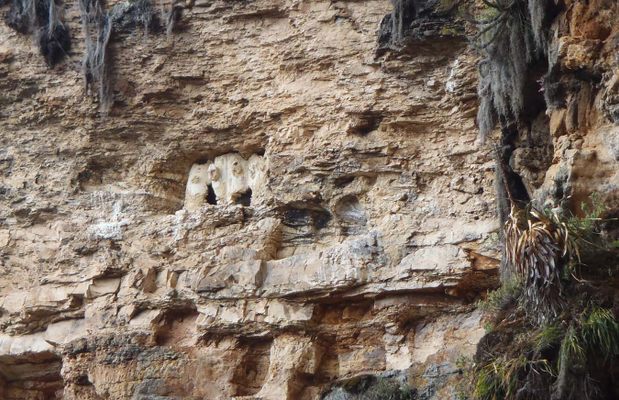About
Staring down from a cliffside in a Peruvian river gorge, the vertical Sarcophagi of Carajía (or Karijia) kept watch over the Utcabamba Valley for hundreds of years before researchers were able to climb up and investigate the mysterious mummies.
Created some time in the 15th century by the Chachapoya civilization the seven standing burial capsules (formerly eight, although one of them collapsed during a 1928 earthquake) are located almost 700 feet above the valley floor. While a great deal of the Chachapoya culture was lost after being conquered by the Incan people and simply through time, the sarcophagi survived largely intact due to their seemingly impossible location. Each of the figures stands a remarkable eight feet tall and change, constructed out of grass and clay and built right into the cliff face. Some of the graves even still retain the human skulls that were installed atop the sarcophagi.
It was not until the mid-19th century that researchers were able to scale the cliff face and examine the mummies, dating them and speculating as to their construction. It is believed that the original architects of these graves worked from natural outcroppings which were later destroyed, either deliberately or naturally. While the sarcophagi are largely protected from the elements by the rock walls around them, birds and other small animals have done some amount of damage. The researchers removed the contents of the sarcophagi to preserve the ancient innards from any further predation.
Related Tags
Peru: Machu Picchu & the Last Incan Bridges
Discover Inca Wonders.
Book NowCommunity Contributors
Added By
Published
December 22, 2015
Sources
- http://en.wikipedia.org/wiki/Caraj%C3%ADa
- http://archive.archaeology.org/0801/abstracts/chachapoya.html
- http://en.wikipedia.org/wiki/Sarcofagi_of_Caraj%C3%ADa
- https://www.google.com/maps/place/Sarcofagos+de+Karajia/@-6.1625929,-78.0235793,17z/data=!3m1!4b1!4m5!3m4!1s0x91b41b2a18799f43:0x64e1f8fdc32792a8!8m2!3d-6.1625982!4d-78.0213853































